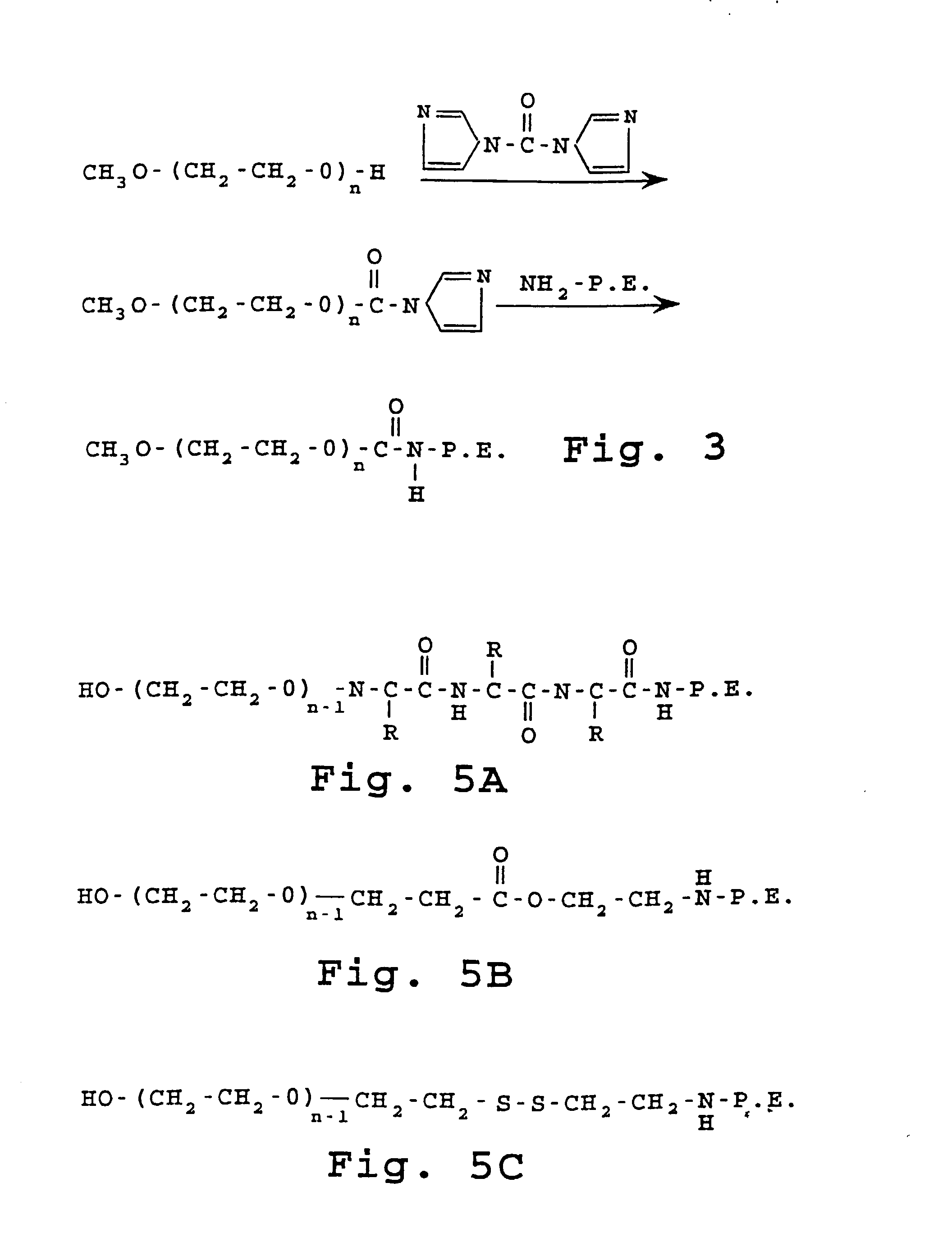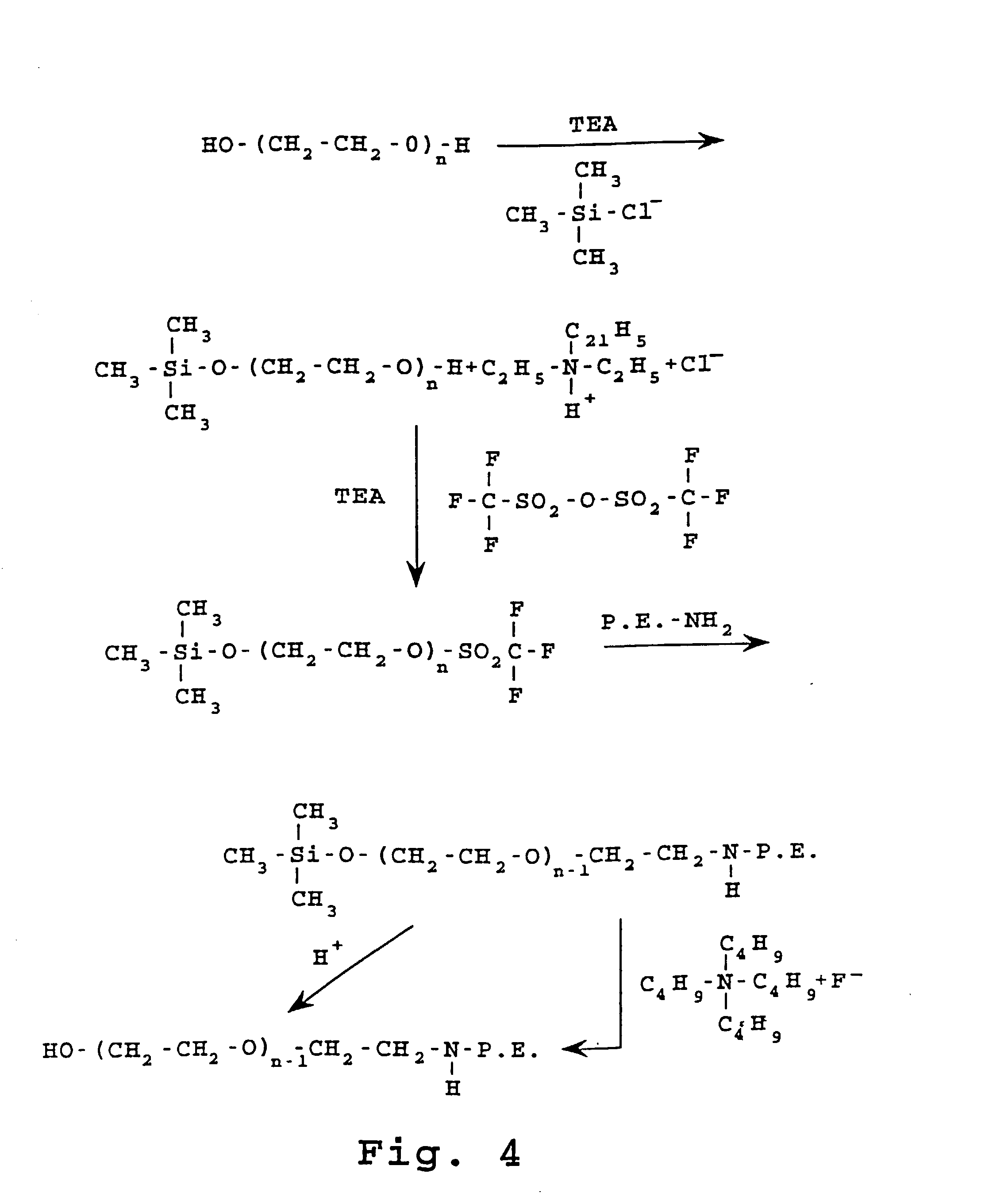Liposomes with enhanced circulation time and method of treatment
a technology of liposomes and blood circulation time, applied in the field of liposome composition and method, can solve the problems of severe restrictions in the use of liposomes for site-specific targeting via the bloodstream, and no single factor identified to date has been effective in providing long blood halfli
- Summary
- Abstract
- Description
- Claims
- Application Information
AI Technical Summary
Problems solved by technology
Method used
Image
Examples
example 1
Preparation of PEG-PE Linked by Cyanuric Chloride
[0155] A. Preparation of activated PEG
[0156] 2-O-Methoxypolyethylene glycol 1900-4,6-dichloro-1,3,5 triazine previously called .alpha.-tivated PEG was prepared as described in J. Biol. Chem., 252:3582 (1977) with the following modifications.
[0157] Cyanuric chloride (5.5 g; 0.03 mol) was dissolved in 400 ml of anhydrous benzene containing 10 g of anhydrous sodium carbonate, and PEG-1900 (19 g; 0.01 mol) was added and the mixture was stirred overnight at room temperature. The solution was filtered, and 600 ml of petroleum ether (boiling range, 35-60.degree.) was added slowly with stirring. The finely divided precipitate was collected on a filter and redissolved in 400 ml of benzene. The precipitation and filtration process was repeated several times until the petroleum ether was free of residual cyanuric chloride as determined by high pressure liquid chromatography on a column (250.times.3.2 mm) of 5-m "LiChrosorb" (E. Merck), developed...
example 2
Preparation of Carbamate and Amide Linked Hydrophilic Polymers with PE
[0165] A. Preparation of the Imidazole Carbamate of Polyethylene Glycol Methyl Ether 1900.
[0166] 9.5 grams (5 mmoles) of polyethylene glycol methyl ether 1900 obtained from Aldrich Chemical Co. was dissolved in 45 ml benzene which has been dried over molecular sieves. 0.89 grams (5.5 mmoles) of pure carbonyl diimidazole was added. The purity was checked by an infra-red spectrum. The air in the reaction vessel was displaced with nitrogen. Vessel was enclosed and heated in a sand bath at 75.degree. C. for 16 hours.
[0167] The reaction mixture was cooled and the clear solution formed at room temperature. The solution was diluted to 50.0 ml with dry benzene and stored in the refrigerator as a 100 micromole / ml stock solution of the imidazole carbamate of PEG ether 1900.
[0168] B. Preparation of the Phosphatidylethanolamine Carbamate of Polyethylene Glycol Methyl Ether 1900.
[0169] 10.0 ml (1 mmol) of the 100 mmol / ml stock...
example 3
Preparation of Ethylene-Linked PEG-PE
[0206] A. Preparation of 1-trimethylsilyloxy-polyethylene Glycol is Illustrated in the Reaction Scheme Shown in FIG. 3.
[0207] 15.0 gm (10 mmoles) of polyethylene glycol) M.Wt. 1500, (Aldrich Chemical) was dissolved in 80 ml benzene. 1.40 ml (11 mmoles) of chlorotrimethyl silane (Aldrich Chemical Co.) and 1.53 ml (1 mmoles) of triethylamine was added. The mixture was stirred at room temperature under an inert atmosphere for 5 hours.
[0208] The mixture was filtered with suction to separate crystals of triethylammonium chloride and the crystals were washed with 5 ml benzene. Filtrate and benzene wash liquids were combined. This solution was evaporated to dryness under vacuum to provide 15.83 grams of colorless oil which solidified on standing.
[0209] TLC of the product on Si--Cl.sub.8 reversed-phase plates using a mixture of 4 volumes of ethanol with 1 volume of water as developer, and iodine vapor visualization, revealed that all the polyglycol 1500 ...
PUM
| Property | Measurement | Unit |
|---|---|---|
| molecular weight | aaaaa | aaaaa |
| molecular weights | aaaaa | aaaaa |
| melting temperature | aaaaa | aaaaa |
Abstract
Description
Claims
Application Information
 Login to View More
Login to View More - R&D
- Intellectual Property
- Life Sciences
- Materials
- Tech Scout
- Unparalleled Data Quality
- Higher Quality Content
- 60% Fewer Hallucinations
Browse by: Latest US Patents, China's latest patents, Technical Efficacy Thesaurus, Application Domain, Technology Topic, Popular Technical Reports.
© 2025 PatSnap. All rights reserved.Legal|Privacy policy|Modern Slavery Act Transparency Statement|Sitemap|About US| Contact US: help@patsnap.com



